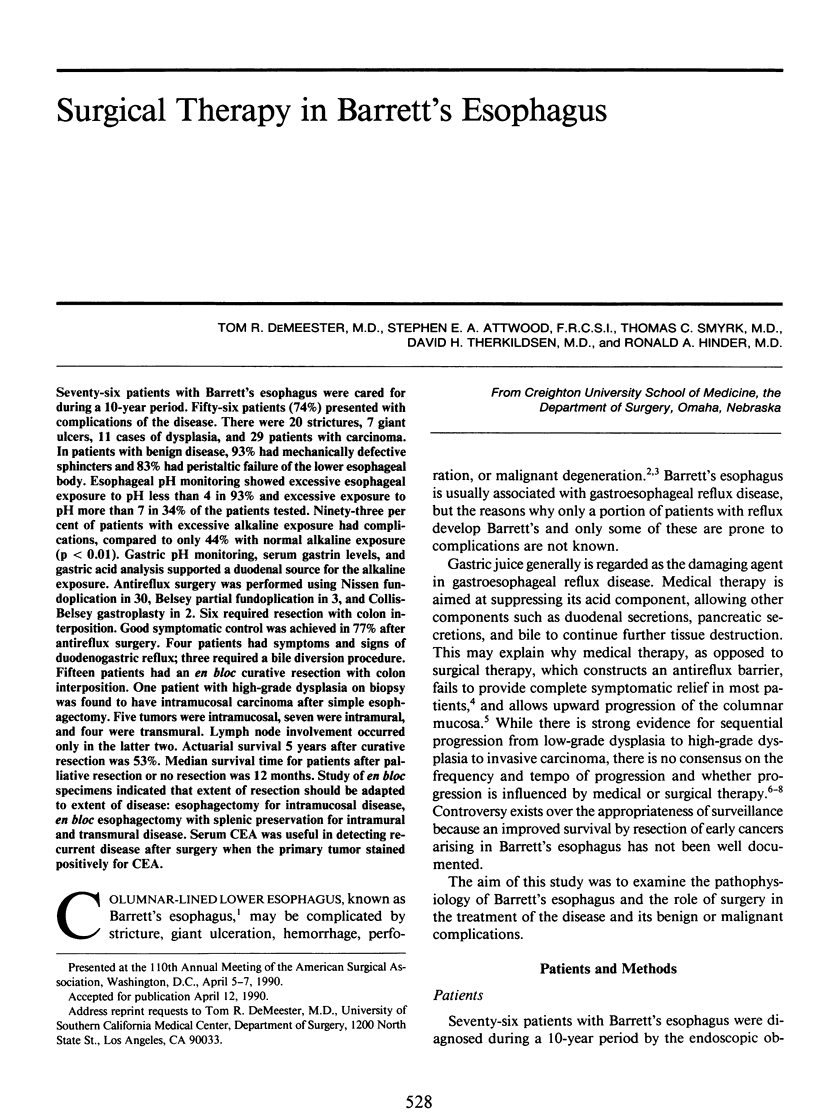Abstract
Seventy-six patients with Barrett's esophagus were cared for during a 10-year period. Fifty-six patients (74%) presented with complications of the disease. There were 20 strictures, 7 giant ulcers, 11 cases of dysplasia, and 29 patients with carcinoma. In patients with benign disease, 93% had mechanically defective sphincters and 83% had peristaltic failure of the lower esophageal body. Esophageal pH monitoring showed excessive esophageal exposure to pH less than 4 in 93% and excessive exposure to pH more than 7 in 34% of the patients tested. Ninety-three per cent of patients with excessive alkaline exposure had complications, compared to only 44% with normal alkaline exposure (p less than 0.01). Gastric pH monitoring, serum gastrin levels, and gastric acid analysis supported a duodenal source for the alkaline exposure. Antireflux surgery was performed using Nissen fundoplication in 30, Belsey partial fundoplication in 3, and Collis-Belsey gastroplasty in 2. Six required resection with colon interposition. Good symptomatic control was achieved in 77% after antireflux surgery. Four patients had symptoms and signs of duodenogastric reflux; three required a bile diversion procedure. Fifteen patients had an en bloc curative resection with colon interposition. One patient with high-grade dysplasia on biopsy was found to have intramucosal carcinoma after simple esophagectomy. Five tumors were intramucosal, seven were intramural, and four were transmural. Lymph node involvement occurred only in the latter two. Actuarial survival 5 years after curative resection was 53%. Median survival time for patients after palliative resection or no resection was 12 months. Study of en bloc specimens indicated that extent of resection should be adapted to extent of disease: esophagectomy for intramucosal disease, en bloc esophagectomy with splenic preservation for intramural and transmural disease. Serum CEA was useful in detecting recurrent disease after surgery when the primary tumor stained positively for CEA.
Full text
PDF












Images in this article
Selected References
These references are in PubMed. This may not be the complete list of references from this article.
- BARRETT N. R. Chronic peptic ulcer of the oesophagus and 'oesophagitis'. Br J Surg. 1950 Oct;38(150):175–182. doi: 10.1002/bjs.18003815005. [DOI] [PubMed] [Google Scholar]
- Barlow A. P., DeMeester T. R., Ball C. S., Eypasch E. P. The significance of the gastric secretory state in gastroesophageal reflux disease. Arch Surg. 1989 Aug;124(8):937–940. doi: 10.1001/archsurg.1989.01410080069011. [DOI] [PubMed] [Google Scholar]
- Bremner C. G. Barrett's oesophagus. Br J Surg. 1989 Oct;76(10):995–996. doi: 10.1002/bjs.1800761002. [DOI] [PubMed] [Google Scholar]
- DeMeester T. R., Barlow A. P. Surgery and current management for cancer of the esophagus and cardia: Part II. Curr Probl Surg. 1988 Aug;25(8):535–605. doi: 10.1016/0011-3840(88)90027-5. [DOI] [PubMed] [Google Scholar]
- DeMeester T. R., Bonavina L., Albertucci M. Nissen fundoplication for gastroesophageal reflux disease. Evaluation of primary repair in 100 consecutive patients. Ann Surg. 1986 Jul;204(1):9–20. doi: 10.1097/00000658-198607000-00002. [DOI] [PMC free article] [PubMed] [Google Scholar]
- DeMeester T. R., Johansson K. E., Franze I., Eypasch E., Lu C. T., McGill J. E., Zaninotto G. Indications, surgical technique, and long-term functional results of colon interposition or bypass. Ann Surg. 1988 Oct;208(4):460–474. doi: 10.1097/00000658-198810000-00008. [DOI] [PMC free article] [PubMed] [Google Scholar]
- DeMeester T. R., Zaninotto G., Johansson K. E. Selective therapeutic approach to cancer of the lower esophagus and cardia. J Thorac Cardiovasc Surg. 1988 Jan;95(1):42–54. [PubMed] [Google Scholar]
- Hameeteman W., Tytgat G. N., Houthoff H. J., van den Tweel J. G. Barrett's esophagus: development of dysplasia and adenocarcinoma. Gastroenterology. 1989 May;96(5 Pt 1):1249–1256. doi: 10.1016/s0016-5085(89)80011-3. [DOI] [PubMed] [Google Scholar]
- Hinder R. A., Stein H. J., Bremner C. G., DeMeester T. R. Relationship of a satisfactory outcome to normalization of delayed gastric emptying after Nissen fundoplication. Ann Surg. 1989 Oct;210(4):458–465. doi: 10.1097/00000658-198910000-00006. [DOI] [PMC free article] [PubMed] [Google Scholar]
- Iascone C., DeMeester T. R., Little A. G., Skinner D. B. Barrett's esophagus. Functional assessment, proposed pathogenesis, and surgical therapy. Arch Surg. 1983 May;118(5):543–549. doi: 10.1001/archsurg.1983.01390050027005. [DOI] [PubMed] [Google Scholar]
- Naef A. P., Savary M., Ozzello L. Columnar-lined lower esophagus: an acquired lesion with malignant predisposition. Report on 140 cases of Barrett's esophagus with 12 adenocarcinomas. J Thorac Cardiovasc Surg. 1975 Nov;70(5):826–835. [PubMed] [Google Scholar]
- Orringer M. B. Transhiatal esophagectomy without thoracotomy for carcinoma of the thoracic esophagus. Ann Surg. 1984 Sep;200(3):282–288. doi: 10.1097/00000658-198409000-00005. [DOI] [PMC free article] [PubMed] [Google Scholar]
- Reid B. J., Weinstein W. M., Lewin K. J., Haggitt R. C., VanDeventer G., DenBesten L., Rubin C. E. Endoscopic biopsy can detect high-grade dysplasia or early adenocarcinoma in Barrett's esophagus without grossly recognizable neoplastic lesions. Gastroenterology. 1988 Jan;94(1):81–90. doi: 10.1016/0016-5085(88)90613-0. [DOI] [PubMed] [Google Scholar]
- Riddell R. H., Goldman H., Ransohoff D. F., Appelman H. D., Fenoglio C. M., Haggitt R. C., Ahren C., Correa P., Hamilton S. R., Morson B. C. Dysplasia in inflammatory bowel disease: standardized classification with provisional clinical applications. Hum Pathol. 1983 Nov;14(11):931–968. doi: 10.1016/s0046-8177(83)80175-0. [DOI] [PubMed] [Google Scholar]
- Robertson C. S., Mayberry J. F., Nicholson D. A., James P. D., Atkinson M. Value of endoscopic surveillance in the detection of neoplastic change in Barrett's oesophagus. Br J Surg. 1988 Aug;75(8):760–763. doi: 10.1002/bjs.1800750813. [DOI] [PubMed] [Google Scholar]
- Spechler S. J., Robbins A. H., Rubins H. B., Vincent M. E., Heeren T., Doos W. G., Colton T., Schimmel E. M. Adenocarcinoma and Barrett's esophagus. An overrated risk? Gastroenterology. 1984 Oct;87(4):927–933. [PubMed] [Google Scholar]
- Ulich T. R., Kollin M., Lewin K. J. Composite gastric carcinoma. Report of a tumor of the carcinoma-carcinoid spectrum. Arch Pathol Lab Med. 1988 Jan;112(1):91–93. [PubMed] [Google Scholar]
- Winans C. S., Harris L. D. Quantitation of lower esophageal sphincter competence. Gastroenterology. 1967 May;52(5):773–778. [PubMed] [Google Scholar]
- Zaninotto G., DeMeester T. R., Bremner C. G., Smyrk T. C., Cheng S. C. Esophageal function in patients with reflux-induced strictures and its relevance to surgical treatment. Ann Thorac Surg. 1989 Mar;47(3):362–370. doi: 10.1016/0003-4975(89)90374-3. [DOI] [PubMed] [Google Scholar]
- Zaninotto G., DeMeester T. R., Schwizer W., Johansson K. E., Cheng S. C. The lower esophageal sphincter in health and disease. Am J Surg. 1988 Jan;155(1):104–111. doi: 10.1016/s0002-9610(88)80266-6. [DOI] [PubMed] [Google Scholar]




